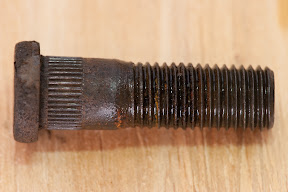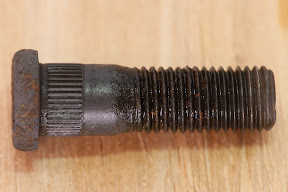One of the first things I found when first looking into building a Locost was the use of electrolysis to remove rust from donor parts. This is described by some as “magical”, so it had to be worth a look.
There seem to be two schools of thought – high current vs. low current. The high current method just uses a 12V battery charger as a power source, whereas the low-current method tries to maintain the current flow at around 250mA by adjusting the applied voltage. The benefit of the low-current method is that it is more gentle, and should be able to convert “intermediate” rust back into iron metal. This should reduce pitting of the final finish. The high-current method generates a lot more gas, and so might loosen rust better than the low-current method making it easier to clean after electrolysis.
I decided to conduct a test to see if the low-current method was worth the extra effort. This test is not overly scientific (scientific tests take a LOT of effort), but was interesting to conduct.
I select two rusty (but not heavily rusted) bolts that I had removed from one of the wheel stubs. They were cleaned in detergent and ammonia to remove any residual grease.

Then two electrolytic cells were built, using the highly scientific jam-jar configuration. One was powered by a wall-wart at 3V, the other by a car charger at 12V (later halved to 6V to avoid meltdown).

The solution consisted of 3g of NaOH (caustic soda) in 1L water. Internet sources indicate fairly varying concentrations (from 2%, which is very strong, to “a tablespoon per gallon”). I think my solution could be a little stronger, but it really does not need to be much stronger. The concentration does not play a large role in the success of the method, so err on the side of weaker. Be very careful with this stuff – it will eat through flesh. It also reacts exo-thermically with water, so fill your cell with water and then slowly drop the crystals into it, not the other way round (i.e. so there’s lots of water to keep things cool)*.
The current was around 300mA for the low-current cell, and initially about 1.2A for the high-current cell. The bolts were left to stew for about 40 hours. After just 2 hours at 12V I realised it was getting too hot (it was too hot to touch) so I dropped it to 6V (and physics tells us that the current would similarly reduce by half). Even at this level the solution produced a large amount of gas. The low-current solution did produce gas, but not much. The liquid level did drop during the course of the experiment (probably a combination of evaporation and that the gas is produced from the water). Another word on the gas – it is an explosive mixture of hydrogen and oxygen so keep the room well ventilated and away from sparks.
Finally the bolts were removed – this is what they looked like:
When cleaned up, the bolts looked like this:

A nylon nail-brush and a green plastic scourer were the only things used for cleaning. The high-current bolt wasn’t noticeably easier to clean, although it ended up shinier than the other. It also seemed cleaner to start with (whereas the low-current bolt looked almost unchanged from the start).
Careful examination of the bolts seems to indicate that the high-current bolt is more pitted than the low-current bolt. A double-blind statistical analysis revealed that the low-current bolt was indeed less pitted (i.e I asked the missus for her opinion without telling her which was which. I didn’t look at the her or the bolts during this process, hence it qualifies as double-blind).
My conclusion is that the low-current method results in a better final product, with more of the original metal recovered from the rust. I’ll be using this method, aiming for about 250mA.
I also finished construction of my large-scale electrolysis cell:
|
|
The anode has been constructed from mild steel, and is supposed to provide maximum line of sight interaction with the subject being treated. When the uprights are back from machining they will be the first subjects.
B
* The author accepts no responsibility for any damage you do to yourself, others, your stuff, small furry animals that live near you, downstream from you, upstream from you, non-furry animals living in the same places or other places to furry animals, furry and non-furry non-animals, squirrels, as a result of you reading and/or acting on the content of this website. Actually, let me know about the squirrels – send photos.



